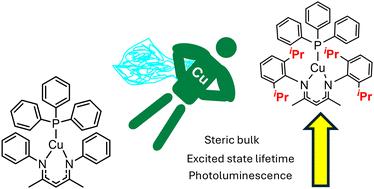当前位置:
X-MOL 学术
›
Dalton Trans.
›
论文详情
Our official English website, www.x-mol.net, welcomes your
feedback! (Note: you will need to create a separate account there.)
Photophysical properties of three-coordinate heteroleptic Cu(I) β-diketiminate triarylphosphine complexes
Dalton Transactions ( IF 3.5 ) Pub Date : 2024-11-18 , DOI: 10.1039/d4dt02681k Ashish Kumar, Dooyoung Kim, Giao Nguyen, Chenggang Jiang, Soumi Chakraborty, Thomas S. Teets
Dalton Transactions ( IF 3.5 ) Pub Date : 2024-11-18 , DOI: 10.1039/d4dt02681k Ashish Kumar, Dooyoung Kim, Giao Nguyen, Chenggang Jiang, Soumi Chakraborty, Thomas S. Teets

|
A series of heteroleptic copper(I) β-diketiminate triarylphosphine complexes is reported, having the general formula Cu(R1NacNacR2)(PPhX3), where R1NacNacR2 is a substituted β-diketiminate and PPhX3 is a triphenylphosphine derivative. A total of five different R1NacNacR2 ligands and three different triarylphosphines are used to assemble the nine complexes. The syntheses, X-ray crystal structures, cyclic voltammograms, and UV–vis absorption spectra of all compounds are described. Whereas most of the compounds are weakly luminescent or only luminesce at 77 K, the four complexes with the more sterically encumbered β-diketiminate ligands, with methyl or isopropyl substituents at the 2- and 6-positions of the N-phenyl rings, exhibit weak room-temperature photoluminescence with peaks between 519 and 566 nm and long excited-state lifetimes in the range of 15–70 μs. The sterically encumbering substituents in this subset have subtle effects on the UV–vis absorption maximum, which red shifts slightly as the steric bulk increases, as well as significant effects on the photoluminescence lifetime, which is observed to increase as the steric bulk is augmented. Substituents on the triarylphosphine also influence the excited-state dynamics in the bulky complexes, with the more electron-rich tris(4-methoxyphenyl)phosphine (PPhOMe3) giving longer-excited-state lifetimes compared to triphenylphosphine (PPh3) when the same R1NacNacR2 ligand is used.
中文翻译:

三配位异位 Cu(I) β-二酮酸三芳基膦配合物的光物理性质
报道了一系列异卵铜 () β-二烯酸三芳基膦配合物,通式为 Cu(R1NacNacR2)(PPhX3),其中 R1NacNacR2 是取代的 β-二烯酸酯,PPhX3 是三苯基膦衍生物。总共使用五种不同的 R1NacNacR2 配体和三种不同的三芳基膦来组装这九种复合物。描述了所有化合物的合成、X 射线晶体结构、循环伏安图和紫外-可见吸收光谱。虽然大多数化合物是弱发光的或仅在 77 K 下发光,但具有更多空间位阻的 β-二酮基酸酯配体的四种络合物,在 N-苯基环的 2 位和 6 位具有甲基或异丙基取代基,表现出微弱的室温光致发光,峰值在 519 至 566 nm 之间,激发态寿命在 15-70 μs 范围内。该子集中的空间位阻取代基对 UV-vis 最大吸收率有微妙的影响,随着空间本体的增加,最大吸收率会略有红移,并且对光致发光寿命也有显著影响,观察到光致发光寿命随着空间本体的增加而增加。三芳基膦上的取代基也会影响大体积配合物中的激发态动力学,当使用相同的 R1NacNacR2 配体时,与三苯基膦 (PPh 3) 相比,电子含量更高的三(4-甲氧基苯基)膦 (PPhOMe3) 具有更长的激发态寿命。
更新日期:2024-11-18
中文翻译:

三配位异位 Cu(I) β-二酮酸三芳基膦配合物的光物理性质
报道了一系列异卵铜 () β-二烯酸三芳基膦配合物,通式为 Cu(R1NacNacR2)(PPhX3),其中 R1NacNacR2 是取代的 β-二烯酸酯,PPhX3 是三苯基膦衍生物。总共使用五种不同的 R1NacNacR2 配体和三种不同的三芳基膦来组装这九种复合物。描述了所有化合物的合成、X 射线晶体结构、循环伏安图和紫外-可见吸收光谱。虽然大多数化合物是弱发光的或仅在 77 K 下发光,但具有更多空间位阻的 β-二酮基酸酯配体的四种络合物,在 N-苯基环的 2 位和 6 位具有甲基或异丙基取代基,表现出微弱的室温光致发光,峰值在 519 至 566 nm 之间,激发态寿命在 15-70 μs 范围内。该子集中的空间位阻取代基对 UV-vis 最大吸收率有微妙的影响,随着空间本体的增加,最大吸收率会略有红移,并且对光致发光寿命也有显著影响,观察到光致发光寿命随着空间本体的增加而增加。三芳基膦上的取代基也会影响大体积配合物中的激发态动力学,当使用相同的 R1NacNacR2 配体时,与三苯基膦 (PPh 3) 相比,电子含量更高的三(4-甲氧基苯基)膦 (PPhOMe3) 具有更长的激发态寿命。


















































 京公网安备 11010802027423号
京公网安备 11010802027423号